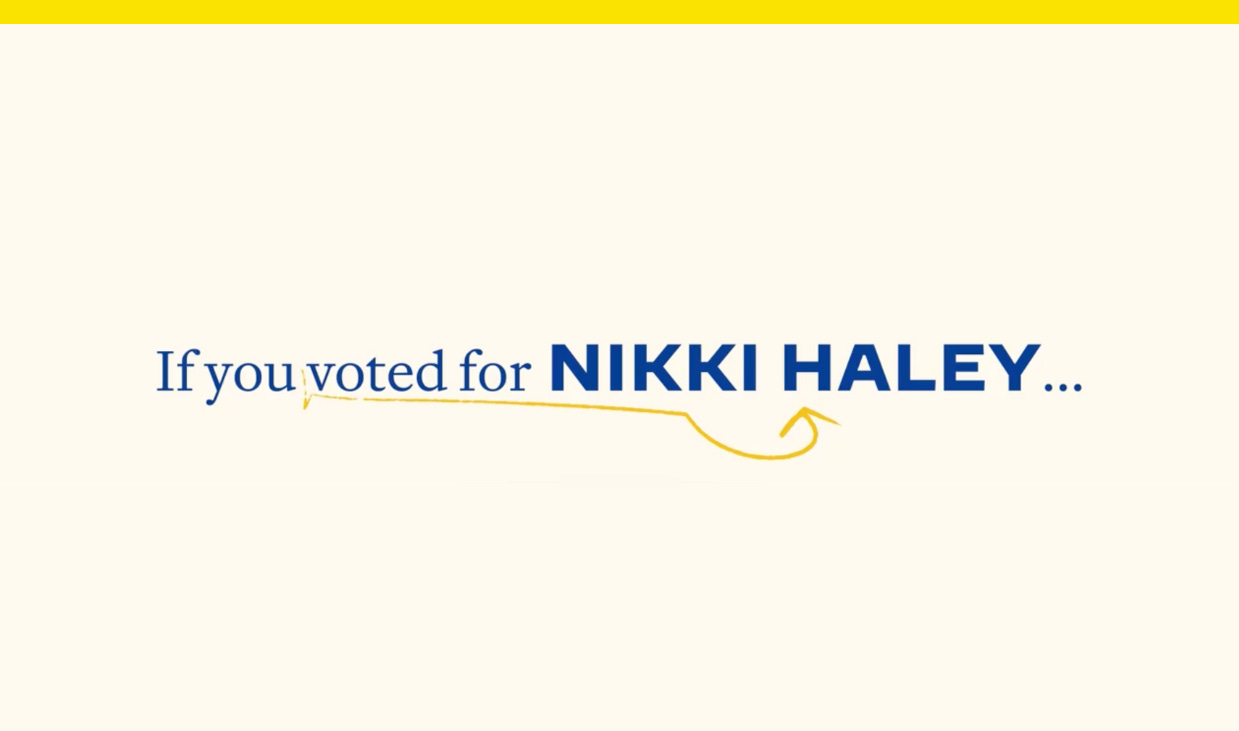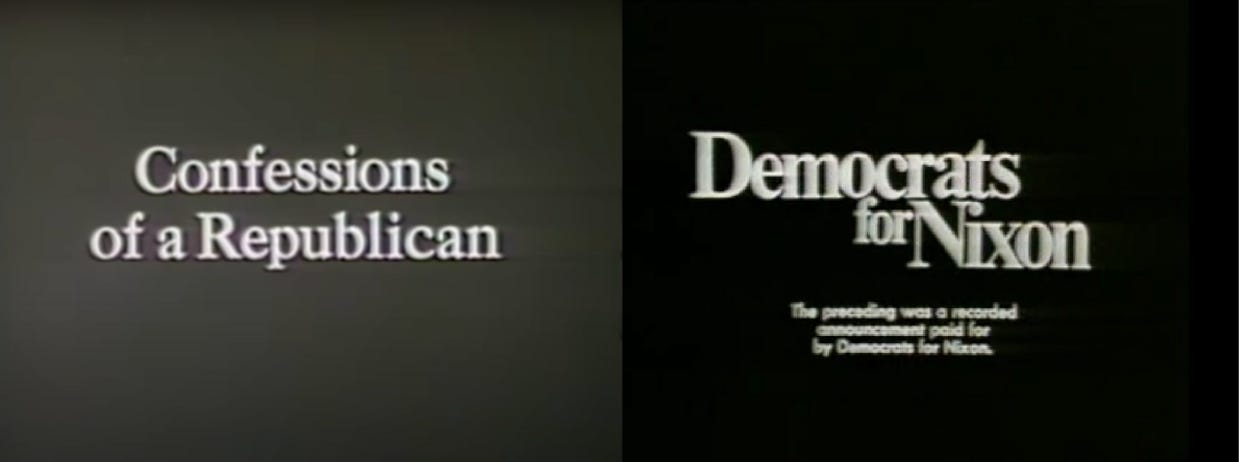Why the Biden campaign is courting Haley voters
Plus: This addiction recovery PSA campaign is trying something different. It’s showing the pills.
Hello, in this issue we’ll look at…
Why the Biden campaign is courting Haley voters
How incumbents use outpartisans in ads to convince voters to ditch their party
This addiction recovery PSA campaign is trying something different. It’s showing the pills.
Scroll to the end to see: which party is more strategic in its emails
Why the Biden campaign is courting Haley voters
President Joe Biden couldn’t have won the White House without help from Republicans, and his campaign is reaching out to them via a new ad in hopes it can win their votes this year.
In 2020, Biden won 16% of the moderate and liberal Republican vote, double the 8% that former Secretary of State Hillary Clinton won in 2016, according to data from the Pew Research Center. Biden also improved on Clinton’s performance among independents by 10 points and among moderate and conservative Democrats by six points. Make no mistake, Centrists are a crucial piece of the Biden coalition.
To be sure, every election has a degree of cross-party voting, but especially in elections that are expected to be close, being able to win over defectors from your opponents’ party is critical.
Biden’s campaign has begun reaching across the aisle in hopes of winning over voters who supported former Ambassador Nikki Haley in a new ad titled “If You Voted for Nikki Haley…” The 30-second spot has comments from former President Donald Trump disparaging Haley during the primary, including a Truth Social post saying Haley’s donors would be “permanently barred from the MAGA camp.”
“If you voted for Nikki Haley… Donald Trump doesn’t want your vote,” reads the Biden campaign ad’s copy. “Save America. Join us.”
Haley didn’t endorse Trump after dropping out of the race last month, joining a growing list of former Trump administration members who aren’t backing him in 2024, including former Vice President Mike Pence, former Attorney General Bill Barr, and former Defense Secretary Jim Mattis. Whether Haley’s supporters feel the same way and are open to voting for Biden, though, remains an open question.
NBC News exit polls on Super Tuesday found about half of Haley supporters in Virginia and North Carolina approved of Biden’s job performance, yet data from Resonate, a Reston, Virginia-based consumer intelligence company found just 9% of Haley voters plan to vote for Biden. Another 6% said they plan to leave the presidential race blank and only vote down ballot and 19% plan to vote third party or write in another candidate’s name.
Biden’s campaign, however, is optimistic. At a meeting in New York City Friday organized by the Biden National Finance Committee, Biden campaign chair Jen O’Malley Dillon showed the “If You Voted for Nikki Haley…” ad and told attendees they believe Haley voters are gettable, according to Politico.
How incumbents use outpartisans in ads to convince voters to ditch their party
So far the ad has only been posted to social media without any paid placement behind it, but it represents a much earlier attempt to woo outpartisans than four years ago. In August 2020, the Biden campaign organized a Republicans for Biden initiative with endorsements from former Sen. Jeff Flake (R-Ariz.), former Ohio Gov. John Kasich, and more than two dozen former Republican members of Congress.
Using members of the opposite party is effective because it allows for a permission structure for voters to cross party lines. If a conservative like Flake is voting for Biden, the thinking goes, well then maybe I can too. It’s not a blue-haired ~w0ke~ liberal who drives a Prius asking for your vote, it’s someone from your political “tribe.”
A memo from the conservative Club for Growth last year found the most effective ads against Trump featured voters who said they voted for him in the past but wouldn’t again, and similarly, Flake said in his 2020 video announcing his Biden endorsement that he was backing Biden “because of my conservatism.”
That tactic has proven effective before, particularly for incumbents running against an opponent viewed as outside the mainstream.
In 1964, Lyndon Johnson campaign ran a “Confessions of a Republican” ad starring a man who says though he’s Republican from a Republican family, Barry Goldwater “scares me.” The Johnson campaign sometimes scheduled the ad to air following 30-minute Goldwater spots to get it in front of its intended audience.
During Richard Nixon’s 1972 reelection campaign, his team used ads tagged “Democrats for Nixon” to go after George McGovern using lines of attack previously brought up by Hubert Humphrey during the Democratic primary. The campaign found ads with the “Democrats for Nixon” tag outperformed the same ads with a “Committee to Re-elect the President” tag even though they were both produced by the November Group, Nixon’s in-house agency, and “Democrats for Nixon” ads were among the most aired spots of the campaign.
Of course these cross-party ads aren’t a silver bullet. In 2016, Clinton’s campaign revived “Confessions of a Republican” with an updated version starring the same man, Bill Bogert. “This man scares me,” he said of Trump. Fifty-two years later, though, voters found his his argument less convincing.
This addiction recovery PSA campaign is trying something different. It’s showing the pills.
A new PSA is taking an unusual approach to helping people recover from opioid addiction. Instead of hiding drugs from sight, the PSA puts the pills front and center.
For the 855-HOW-TO-QUIT campaign, designers transformed pill imprint codes into phone extensions that people can call to connect with people who’ve recovered from opioid addiction. It’s a bit of graphic design cleverness that, admittedly, not even the designers weren’t confident would end up as the final approach.
Addiction recovery campaigns often focus on cautionary tales, says Pablo Marquez, chief creative officer at Raw Materials, who alongside German ad agency, Serviceplan, designed the campaign. Marquez says those stories are “necessary and useful,” but Raw Materials wanted to approach the problem from a different angle.
They landed on the idea of showcasing 30 of the most common opioid pills as a way to tell 30 different stories about recovery from addiction. The designers crafted each pill from scratch as to not infringe on copyright. Each has a keypad code so callers can directly connect with someone who quit that specific pill.
“The thing was, how do you do this without glorifying the pill?” Marquez says. “We were all critics of the idea at the start . . . [asking ourselves] are we making this feel like a candy shop?”
Flindt Andersen, the founder of PAIN, a Fresno, California-based rehabilitation services nonprofit involved in the campaign, believes the campaign will be effective for those who need it. “There are people out there, they’re going to probably go ‘why are they having the pill front and center,‘’ says Andersen, who has been sober for 24 years. “I think this is a good way to at least get the addict to start placing a phone call, because recovery doesn’t doesn’t begin until that phone call is made.”
The helpline features stories from 30 people talking about how they became addicted and how they quit. Emily, who recovered from an oxycodone addiction, speaks about taking Ibuprofen, vitamins, water, and food to handle withdrawal symptoms. And Juan, who recovered from hydromorphone addiction, speaks about receiving medication-assisted treatment at a clinic where staff “never judged me, they just cared for me,” he says. “It’s very important for us to be able to talk to somebody that understands exactly what we’re going through.”
The campaign began running March 5 with plans to place billboards near pharmacies. Soon, print, TV, and digital digital ads will find placement next to pharmaceutical ads, according to organizers. The campaign’s planners will tailor the ads to show whichever pills are most prevalent in a city. In Philadelphia, for example, ads will show fentanyl and oxycodone pills, while in Washington state it’s hydrocodone pills.
Nearly 108,000 Americans died of drug overdoses in the U.S. in 2022, according to the CDC, a record, and opioids were involved in about three-fourths of those deaths.
The campaign was a group effort, with creative partners including the Munich-based design studio Kimera, the Los Angeles-based production company JOJX, and DaHouse, an audio production company. Nonprofits We Are Those People and Upstate Foundation Clinic and the healthcare consultancy Anzen Health were also involved in the campaign, as were the media agencies Mediaplus and Talon.
Have you seen this?
I studied 180K-plus emails from members of Congress. Republicans design their communication more strategically than Democrats. Republicans in Congress are more consistent in using key terms and phrases than Democrats, and Republicans use more images than Democrats and tend to refer constituents to more media outlets, including those that support right-wing views. [Fast Company]
Ambush releases limited-edition Beyoncé t-shirt for the release of Cowboy Carter. This ain’t Texas. [Hypebeast]
When you both have a Canva subscription. They might not agree on much, but the offices for California’s Democratic Gov. Gavin Newsom and Florida’s Republican Gov. Ron DeSantis do share graphics for their Easter posts on social media. [Lara Korte/X]
So that’s what Trump’s hair looks like from above and behind. A user uploaded this photo he says was taken in 2013, when Trump attended Wrestlemania. The photo was published with a Creative Commons license, so it’s free to share and remix with attribution. Incredible.
🔒Why Trump’s having trouble reaching voters with his Truth Social content strategy. Trump’s posts on Truth Social in 2022 were embedded in fewer news articles and they generated less news coverage than his tweets did in 2016, according to analysis in a new study. [Yello]
History of political design
America Reagan Country poster (1980). This poster showing Ronald Reagan in a cowboy hat with images of U.S. landmarks like Mount Rushmore, the National Mall, and the Statue of Liberty, was released by the Reagan-Bush Committee.
A portion of this newsletter was first published in Fast Company.
Want more stories like these? Subscribe to support my work and get unlimited access:














Hi there, what about Universal Basic Income (UBI) in the current debates?? All over the world experiments show the positive impact (against poverty, plus entrepreneurship, equal opportunities, less stress, the same will to work only under better conditions; improved communication based on safety and so forth.
So, one can win a year UBI ($850 per month) and experience it. Free registration on UBI4ALL.org